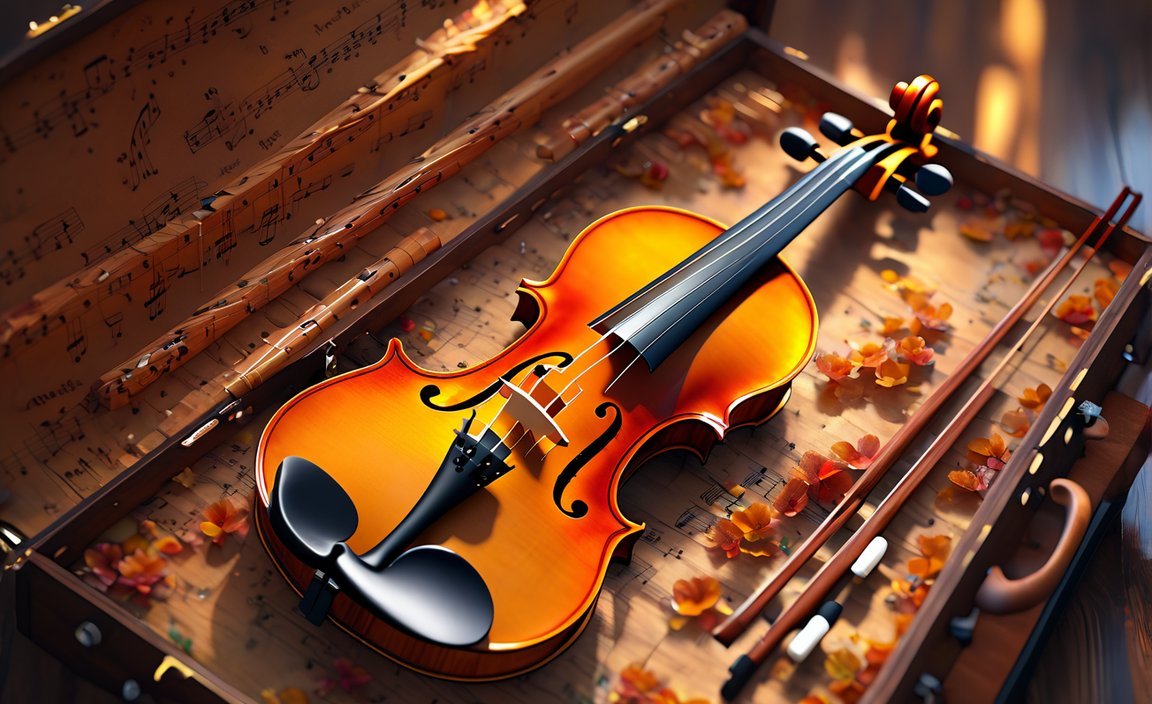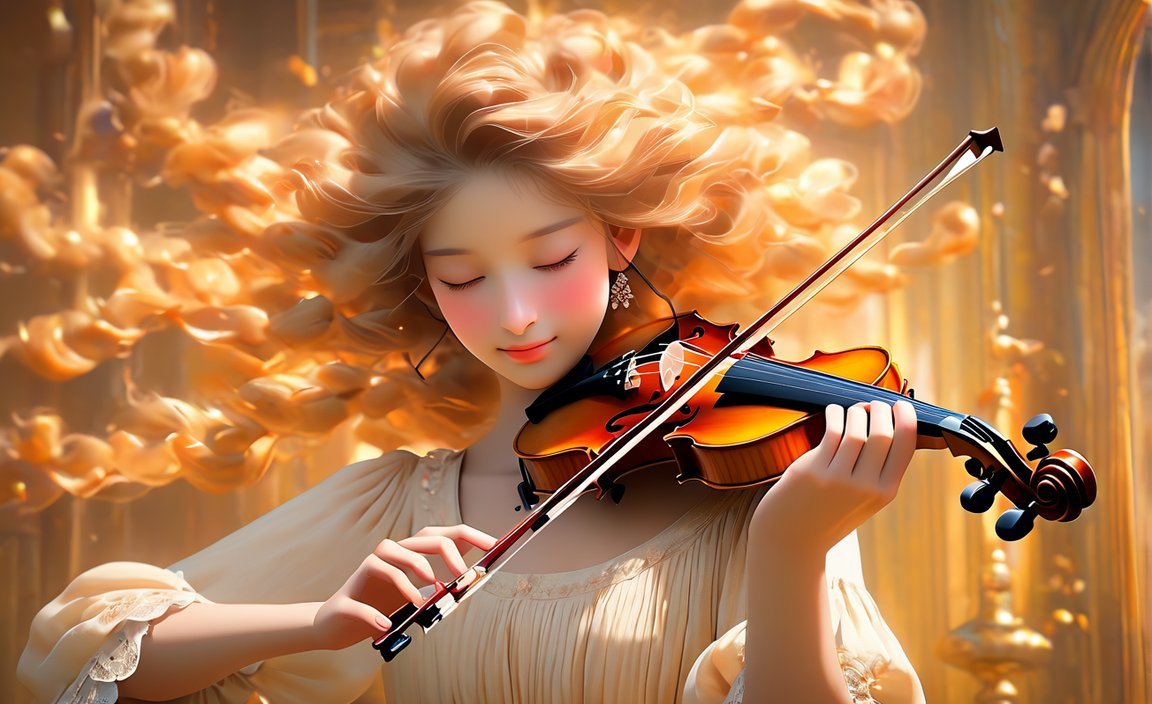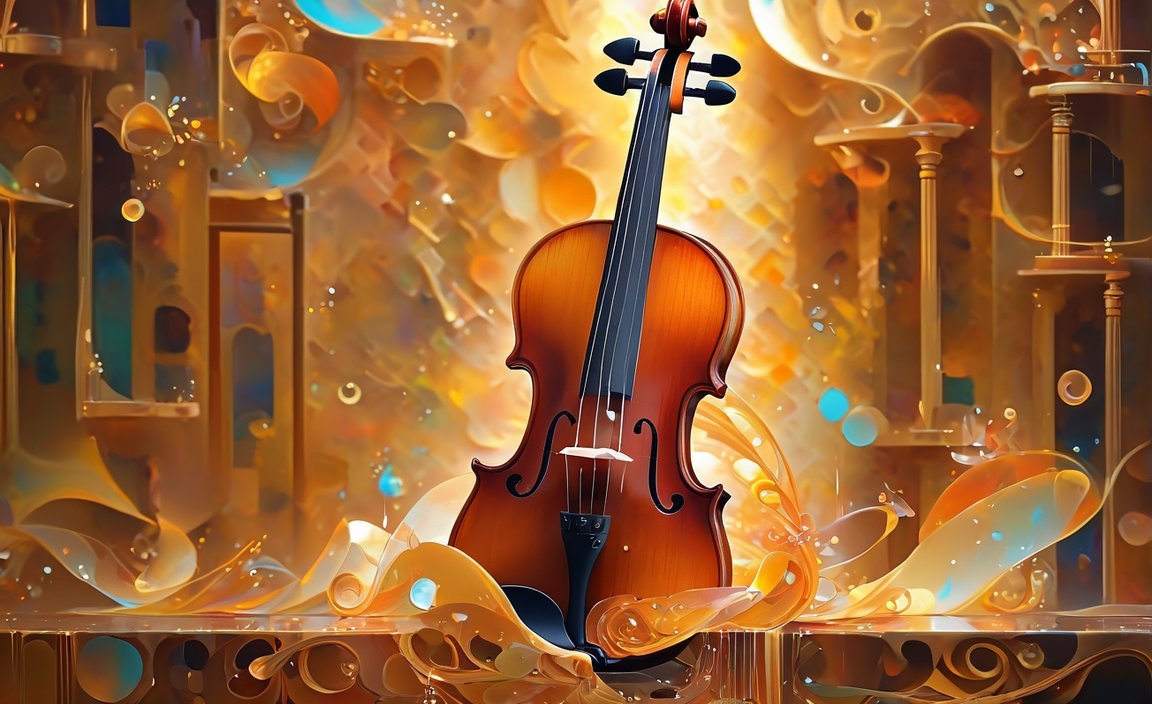The Enchanting Facts of Violins: A Journey into the World of Classical Strings

Immerse yourself in the captivating realm of violins, a magnificent instrument that has mesmerized music lovers for centuries. As we explore the enchanting world of classical strings, we delve into the incredible craftsmanship behind these melodic wonders, unravel the intriguing story of Fritz Kreisler, pay homage to the instrument’s remarkable longevity of nearly 500 years, and discover the extraordinary musical talent of none other than Wolfgang Amadeus Mozart. From the intricate construction of the violin to the profound impact it has had on the realms of both music and history, prepare to be enchanted by these fascinating facts that will deepen your appreciation for this timeless instrument.
Key Takeaways:
- The violin is a four-stringed instrument played with a bow and is the smallest and highest-pitched string instrument used in Western music.
- Its design dates back to the 16th century and was inspired by string instruments from the Byzantine Empire and the Middle East.
- The modern violin is constructed using over 70 different pieces of wood, typically spruce or maple. It is held between the left collar bone and the chin and produces different notes by fingering and bowing.
- The term “violin” comes from the Medieval Latin word “vitula,” meaning “stringed instrument.”
- Violins come in various sizes to accommodate different players, from small violins for children to full-sized ones for adults.
- Playing the violin burns approximately 170 calories per hour.
- The violin is versatile and has been featured in classical, folk, and contemporary music. It has a distinct and recognizable sound.
- Violins are widely distributed globally and hold a significant place in the world of music.
Facts about a Violin
The violin is a fascinating string instrument that has captured the hearts of musicians and music enthusiasts alike for centuries. In this article, we will delve into the enchanting world of violins and uncover some intriguing facts that will deepen your appreciation for this beautiful instrument.
Construction and Design
At the core of the violin’s allure lies its exquisite construction and design. Crafted with precision and expertise, the modern violin is composed of over 70 different pieces of wood, typically spruce or maple. These carefully selected materials contribute to the instrument’s exceptional resonance and tonal qualities. Each violin is meticulously handcrafted by skilled artisans, who devote countless hours to perfecting every curve, joint, and feature.
When playing the violin, it is held snugly between the left collarbone and the chin, allowing the player to have optimal control and reach over the instrument. The left hand skillfully moves along the fingerboard, producing different notes by pressing on the strings, while the right hand expertly guides the bow to create beautiful melodies.
Origin of the Word
Have you ever wondered where the term “violin” originated? Look no further! The word “violin” traces its roots back to the Medieval Latin word “vitula,” which means “stringed instrument.” This linguistic connection highlights the timeless nature of the violin and its enduring role as a beloved instrument throughout history.
Variety in Sizes
With its diverse range of sizes, the violin accommodates players of all ages and statures. From the smallest violins designed for young children to full-sized ones created for adult musicians, there is a perfect fit for everyone. This variability ensures that aspiring violinists can begin their musical journey at a young age, gradually transitioning to larger instruments as they grow.
The Calorie Burn
Beyond its melodic allure, playing the violin offers a physical workout. The intricate movements involved in playing this captivating instrument can burn approximately 170 calories per hour. So, not only does the violin invoke a sense of musical brilliance, but it also provides a rewarding physical activity.
In conclusion, the violin is a mesmerizing instrument that captivates our senses and ignites our passion for music. Whether you are drawn to its impeccable construction, the etymology of its name, its versatile sizes, or the physical benefits it offers, the violin continues to enchant and inspire musicians and audiences worldwide.
For further interesting facts about the violin, you can explore the following sources:
- Just Fun Facts: Interesting Facts About Violins by justfunfacts.com
- Primary Facts: Facts About the Violin by primaryfacts.com
If you’ve ever wondered if carbon is malleable, you’ll be fascinated by what we’ve discovered. Check out our article on carbon malleability to learn more. Is carbon malleable
Explore the intricate forest food chain ecosystem and uncover the fascinating relationships between organisms. Delve deeper into the topic by clicking here. Forest food chain ecosystem
Discover the astonishing food chain of a great white shark, from its prey to its position as an apex predator. Dive into the depths of this incredible ecosystem by clicking here. Food chain of a great white shark
Challenge your knowledge of marine mammals with our exciting word search. Uncover hidden words related to these magnificent creatures and dive into the wonders of the oceans. Start the marine mammals word search now. Marine mammals word search
Embark on a celestial adventure and search for the visible stars in our captivating word search. Discover the wonders of the night sky and expand your astronomical knowledge. Begin your stargazing adventure here. Visible stars word search
Curious about the lifespan of dart frogs? Discover the answer and explore the fascinating world of these colorful amphibians. Start your exploration of dart frogs’ lifespan here. How long do dart frogs live
Immerse yourself in the abiotic factors of the boreal forest and understand the complex interactions that shape this unique ecosystem. Learn more about the boreal forest’s abiotic factors by clicking here. Boreal forest abiotic factors
Uncover the intricate food chain of lions, from their powerful hunts to their role as top predators in their habitats. Dive into the world of these majestic creatures by clicking here. The food chain of a lion
Ever wondered how gemstones work scientifically? Discover the fascinating science behind these precious gems in our article. Unleash the secrets of gemstones by clicking here. How do gemstones work scientifically
Test your knowledge of waves by labeling their various parts in our engaging activity. Enhance your understanding of wave anatomy by clicking here. Label the parts of the wave
Embark on a journey to unravel the atom model of sodium and explore its unique properties. Delve into the atomic world by clicking here. Atom model of sodium
Discover the vibrant bird species that call the savanna home and learn about their fascinating adaptations. Immerse yourself in the enchanting world of savanna birds by clicking here. Birds of the savanna
Uncover the differences between male and female cardinals, from their plumage to their behavior. Dive into the world of cardinals and explore their unique characteristics by clicking here. Difference between male and female cardinals
Ever wondered what a penguin’s mouth looks like? Explore the intriguing features of a penguin’s beak in our captivating article. Satiate your curiosity by clicking here. What does a penguin’s mouth look like
The Violin is Almost 500 Years Old
The violin, a timeless and enchanting instrument, holds a rich history that spans almost half a millennium. Its origins can be traced back to the 16th century, when Italian luthier Andrea Amati is said to have designed the first modern violin. Since then, this elegant stringed instrument has taken center stage in the world of classical music, captivating audiences with its mesmerizing melodies and virtuosic performances.
The violin, the smallest and highest-pitched string instrument in Western music, has played an integral role in European and Arabian musical traditions. Its versatility and expressive capabilities have made it a staple in orchestras, chamber ensembles, and solo performances. The instrument’s distinctive sound, resonating from over 70 carefully crafted pieces of spruce or maple, creates a captivating tonal quality that can transport listeners to a realm of emotions.
Playing the violin is not merely an artistic pursuit; it is also a physical and mental exercise. While producing soul-stirring melodies, violinists engage their bodies in a calorie-burning activity. Indeed, playing the violin can burn approximately 170 calories per hour, providing both a musical and physical workout.
The craftsmanship involved in creating a violin is nothing short of exquisite. Skilled artisans, known as luthiers, meticulously handcraft each instrument, perfecting every curve, joint, and feature. The result is a work of art that embodies both beauty and functionality. The word “violin” itself can be traced back to the Medieval Latin word “vitula,” meaning “stringed instrument,” highlighting the instrument’s historical significance.
The violin comes in a range of sizes to accommodate players of all ages and statures. From the smallest violin ever made, measuring a mere 4 cm, to the more common length of 62 cm, each size allows for a comfortable and ergonomic playing experience. This inclusivity ensures that the violin can be embraced by aspiring musicians of all backgrounds.
No discussion of violins would be complete without mentioning the legendary craftsmanship of Antonio Stradivari, often referred to as Stradivarius. An esteemed violin maker from the 17th and 18th centuries, Stradivari is renowned for producing some of the most sought-after and revered instruments in the world. It is estimated that he crafted about 1,100 violins in his lifetime, with each instrument bearing his signature attention to detail and unparalleled sound quality.
In conclusion, the violin, nearly 500 years old, continues to captivate musicians and audiences worldwide. Its rich history, meticulous craftsmanship, and soul-stirring sounds make it an instrument of enduring beauty and artistic expression.
Key Takeaways:
- The violin is the smallest and highest-pitched string instrument in Western music.
- It was designed by Andrea Amati in the 16th century and has been around for almost 500 years.
- Playing the violin burns approximately 170 calories per hour, offering a physical workout.
- Violins are meticulously handcrafted by skilled artisans known as luthiers.
- The word “violin” traces its roots back to the Medieval Latin word “vitula,” meaning “stringed instrument.”
- Violins come in various sizes to accommodate players of different ages and statures.
- Antonio Stradivari, also known as Stradivarius, is renowned for his exceptional craftsmanship and made around 1,100 instruments.
References:
1. Violin Facts for Kids
2. 10 Interesting Facts About the Violin – Take Note Blog
Mozart was an Accomplished Violinist
The world-renowned composer and pianist, Wolfgang Amadeus Mozart, was not only a master of the keys but also an accomplished violinist. This lesser-known facet of Mozart’s musical prowess adds another layer of fascination to his already extraordinary legacy.
Mozart’s Musical Pedigree and Accomplishments
Mozart’s father, Leopold Mozart, was a skilled violinist himself and played a significant role in nurturing Mozart’s musical talent. Leopold’s expertise as a violinist allowed him to provide his son with a thorough education in both composition and performance.
At a young age, Mozart accompanied his father to various performances, where he not only observed the artistry of his father but also honed his own skills on the violin. By immersing himself in the world of violin music, Mozart developed a deep understanding of the instrument’s nuances and techniques.
The Violin’s Remarkable Journey through Time
The violin has an illustrious history that stretches back nearly 500 years. Its elegant shape and design can be traced back to Andrea Amati, the revered luthier, who is considered the founding father of violin craftsmanship. Amati’s work in the 1500s laid the foundation for the exquisite artistry and meticulous craftsmanship that defines violin-making to this day.
In the realm of violin history, one instrument stands out as the most valuable and highly coveted—the Vieuxtemps. Crafted by luthier Giuseppe Guarneri in 1741, this violin was played by the legendary Belgian virtuoso Henry Vieuxtemps. Its rarity and exceptional tonal qualities make it a true objet d’art in the world of violin collectors and enthusiasts.
Fascinating Tidbits about Violins
Delving deeper into the world of violins, we uncover intriguing facts that add to the instrument’s mystique:
Strings that Connect Generations: Did you know that violin strings were originally made from dried animal intestines? This historical tidbit dubs these strings as “gut strings,” a term still used today in the world of violin music.
Origins Shrouded in Ancestry: The very word “violin” has its roots in the Latin word “vitula,” which translates to “calf” or cow. This etymology may allude to the historical use of animal guts, including those from cows and sheep, to create the strings of the instrument.
Key Takeaways:
– Mozart, renowned for his composition and piano skills, was also an accomplished violinist, thanks to his father’s influence. source
– The violin’s history can be traced back to Andrea Amati, who introduced the elegant design and craftsmanship that characterizes the instrument today. source
– The Vieuxtemps violin, made by Giuseppe Guarneri in 1741, holds the title of the world’s most expensive violin. source
– Violin strings were historically made from dried animal intestines, hence the term “gut strings.” source
– The word “violin” originates from the Latin word “vitula,” potentially referencing the animal guts used to create the instrument’s strings. source
In conclusion, Mozart’s proficiency on the violin adds yet another dimension to his extraordinary musical legacy. The violin, with its rich history and captivating craftsmanship, continues to mesmerize both musicians and audiences alike. Whether we explore the instrument’s origins or marvel at Mozart’s violin virtuosity, the enchanting world of violins is one that deserves our unwavering attention.
[Source: Hello Music Theory, Music Fans Stack Exchange]

FAQ
Q1: How many pieces is the violin made up of?
A1: The violin is made up of over 70 different pieces of wood, typically spruce or maple.
Q2: What is the story of Fritz Kreisler and the violin?
A2: Fritz Kreisler was a renowned violinist and composer who gained fame for his virtuosic performances. However, he was also known for his talent in creating elaborate hoaxes. One famous incident involved Kreisler attributing a beautiful composition to a forgotten composer from the 18th century. It was later revealed that Kreisler himself had written the piece, showcasing his remarkable ability to mimic the style of older composers.
Q3: How old is the violin?
A3: The violin has been in existence for almost 500 years. Its elegant shape and design are credited to Andrea Amati, a distinguished luthier from the 16th century.
Q4: Was Mozart an accomplished violinist?
A4: Yes, aside from being a renowned composer and pianist, Wolfgang Amadeus Mozart was also an accomplished violinist. His father, Leopold Mozart, who was a highly skilled violinist himself, played a significant role in nurturing Mozart’s musical talent.
Q5: What is the significance of the violin in Mozart’s life?
A5: The violin played a significant role in Mozart’s compositions. He wrote numerous violin concertos and sonatas, demonstrating his deep understanding and appreciation for the instrument’s capabilities.
- China II Review: Delicious Food & Speedy Service - April 17, 2025
- Understand Virginia’s Flag: History & Debate - April 17, 2025
- Explore Long Island’s Map: Unique Regions & Insights - April 17, 2025
















